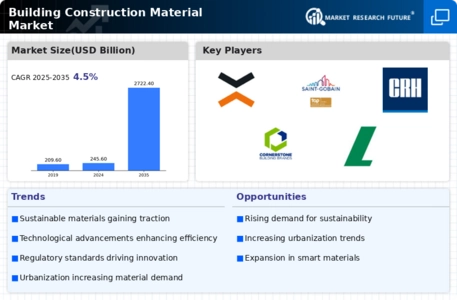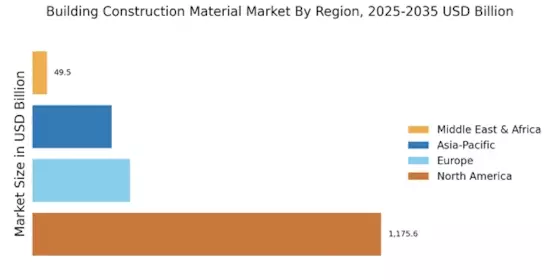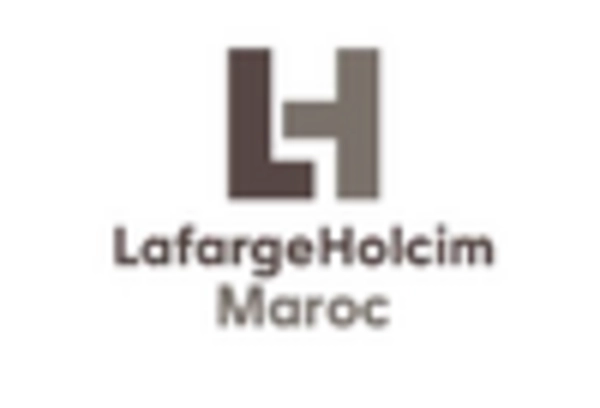Urbanization Trends
Urbanization continues to be a driving force in the Building Construction Material Market, as more individuals migrate to urban areas seeking better opportunities. This demographic shift necessitates the construction of residential, commercial, and infrastructural projects, thereby increasing the demand for various building materials. According to recent data, urban areas are expected to house nearly 70% of the global population by 2050, leading to a surge in construction activities. Consequently, the market for building materials is anticipated to grow in tandem with urban development, with projections indicating a potential increase in demand for concrete, steel, and other essential materials. This urban expansion underscores the critical role of the Building Construction Material Market in accommodating the needs of a growing urban populace.
Technological Innovations
Technological advancements are reshaping the Building Construction Material Market, introducing innovative materials and construction techniques. The integration of smart technologies, such as Building Information Modeling (BIM) and 3D printing, is enhancing efficiency and reducing waste in construction processes. For instance, the adoption of prefabricated materials is gaining traction, allowing for quicker assembly and reduced labor costs. Additionally, the development of high-performance materials, such as self-healing concrete and energy-efficient insulation, is expected to drive market growth. The market for advanced construction technologies is projected to expand significantly, with estimates suggesting a growth rate of around 8% annually. This trend indicates a shift towards more efficient and sustainable construction practices within the Building Construction Material Market.
Sustainability Initiatives
The increasing emphasis on sustainability is a pivotal driver in the Building Construction Material Market. As environmental concerns escalate, stakeholders are prioritizing eco-friendly materials that minimize carbon footprints. This shift is evidenced by a growing demand for recycled and renewable materials, which are projected to account for a substantial portion of the market by 2026. Furthermore, regulations promoting sustainable practices are influencing construction companies to adopt greener alternatives. The market for sustainable building materials is expected to grow at a compound annual growth rate of approximately 10% over the next few years, reflecting a significant transformation in consumer preferences and regulatory frameworks. Consequently, the Building Construction Material Market is likely to witness a robust shift towards sustainable solutions, aligning with broader environmental goals.
Rising Construction Activities
The resurgence of construction activities is a crucial driver in the Building Construction Material Market. As economies recover and expand, there is a marked increase in both residential and commercial construction projects. This uptick is reflected in various market indicators, including a rise in building permits and construction starts. Recent statistics indicate that construction spending is expected to grow by approximately 5% annually, driven by both public and private sector investments. The demand for essential materials such as cement, bricks, and steel is likely to surge as a result. This revitalization of the construction sector not only bolsters the Building Construction Material Market but also creates opportunities for innovation and diversification within the materials segment.
Government Infrastructure Investments
Government investments in infrastructure are significantly influencing the Building Construction Material Market. Many governments are prioritizing infrastructure development to stimulate economic growth and improve public services. This trend is particularly evident in emerging economies, where substantial funding is allocated to transportation, energy, and housing projects. For instance, infrastructure spending is projected to reach trillions of dollars over the next decade, creating a robust demand for construction materials. Such investments not only enhance the quality of life but also drive the growth of the Building Construction Material Market by increasing the consumption of essential materials like asphalt, concrete, and steel. The long-term implications of these investments suggest a sustained demand for building materials, fostering a dynamic market environment.


















Leave a Comment